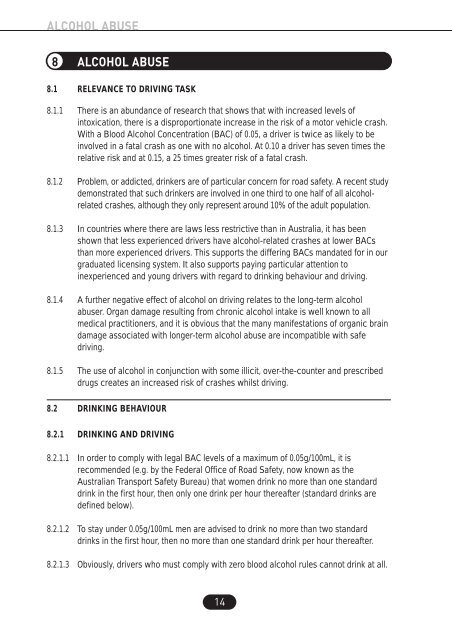Assessing Fitness to Drive - BiOptic Driving Network
Assessing Fitness to Drive - BiOptic Driving Network
Assessing Fitness to Drive - BiOptic Driving Network
- No tags were found...
Create successful ePaper yourself
Turn your PDF publications into a flip-book with our unique Google optimized e-Paper software.
ALCOHOL ABUSE8 ALCOHOL ABUSE8.1 RELEVANCE TO DRIVING TASK8.1.1 There is an abundance of research that shows that with increased levels ofin<strong>to</strong>xication, there is a disproportionate increase in the risk of a mo<strong>to</strong>r vehicle crash.With a Blood Alcohol Concentration (BAC) of 0.05, a driver is twice as likely <strong>to</strong> beinvolved in a fatal crash as one with no alcohol. At 0.10 a driver has seven times therelative risk and at 0.15, a 25 times greater risk of a fatal crash.8.1.2 Problem, or addicted, drinkers are of particular concern for road safety. A recent studydemonstrated that such drinkers are involved in one third <strong>to</strong> one half of all alcoholrelatedcrashes, although they only represent around 10% of the adult population.8.1.3 In countries where there are laws less restrictive than in Australia, it has beenshown that less experienced drivers have alcohol-related crashes at lower BACsthan more experienced drivers. This supports the differing BACs mandated for in ourgraduated licensing system. It also supports paying particular attention <strong>to</strong>inexperienced and young drivers with regard <strong>to</strong> drinking behaviour and driving.8.1.4 A further negative effect of alcohol on driving relates <strong>to</strong> the long-term alcoholabuser. Organ damage resulting from chronic alcohol intake is well known <strong>to</strong> allmedical practitioners, and it is obvious that the many manifestations of organic braindamage associated with longer-term alcohol abuse are incompatible with safedriving.8.1.5 The use of alcohol in conjunction with some illicit, over-the-counter and prescribeddrugs creates an increased risk of crashes whilst driving.8.2 DRINKING BEHAVIOUR8.2.1 DRINKING AND DRIVING8.2.1.1 In order <strong>to</strong> comply with legal BAC levels of a maximum of 0.05g/100mL, it isrecommended (e.g. by the Federal Office of Road Safety, now known as theAustralian Transport Safety Bureau) that women drink no more than one standarddrink in the first hour, then only one drink per hour thereafter (standard drinks aredefined below).8.2.1.2 To stay under 0.05g/100mL men are advised <strong>to</strong> drink no more than two standarddrinks in the first hour, then no more than one standard drink per hour thereafter.8.2.1.3 Obviously, drivers who must comply with zero blood alcohol rules cannot drink at all.14


